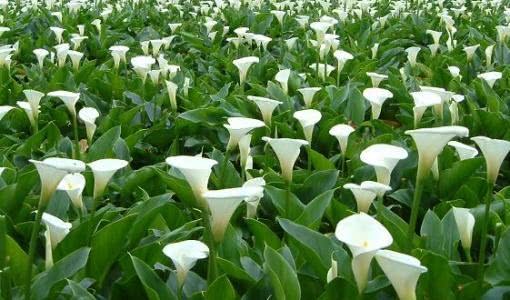Would you like to grow calla lilies at home? Maintenance skills teach you to blossom.

Calla lilies are often called taro. With their white buds, green leaves and graceful plant shape, calla lilies are warmly sought after by many flower friends. In addition to having a good ornamental, it is often used as an important material for cut flowers, as well as a great embellishment for vases, bouquets and baskets. So for calla lilies with poisonous flowers, what should be paid attention to in family cultivation?
I. cultivation of calla lilies
The propagation of calla lily is mainly divided into sowing reproduction and ball reproduction, for family pot cultivation, the use of sowing propagation is more convenient. Prepare an appropriate amount of calla lily seeds, it is best to soak them in water at a temperature of about 20 degrees for 24-48 hours before sowing, which helps to break the sleep of the seeds and facilitate the rooting and germination of plants. After sowing, there is no need for immediate watering, wait for a week or so, the plant germinated and then the right amount of watering, at this time can not be placed in the sun to grow.
After about 20 days, the plant can grow a few true leaves, at this time calla lilies can enter the normal management. It should be noted that the ambient temperature of plants needs to be kept within a stable range before germination, and the most appropriate time is 18-24 degrees. If the temperature difference between day and night is too large, it is likely to cause seeds not to germinate normally.
II. Maintenance of calla lilies
1. Light
Calla lily must have a lot of light in the growth process to ensure its normal growth. If it grows in a dark environment or lack of light for a long time, the leaves of the plant will easily become withered and yellowed. At the same time, the rate of bud formation becomes slow, and the flowering period will be delayed or even unable to bloom normally. Especially in winter, it is best to put the potted plants in the sunny place and accept the all-day sunlight. If in the summer with strong light, the potted plants can be placed in the backlit place to grow. The sun is more violent in the afternoon in summer. You can also make a certain shading treatment.
two。 Soil
Potted calla lily container selection is more fastidious, generally to use the depth of 35-50 cm between the flowerpot or porcelain, should not be too shallow. The soil had better be sandy soil with high fertility and good drainage, and do not use clayey soil, otherwise it may lead to the normal development of plants, usually with rotten leaf soil, and then mixed with appropriate amount of sandy soil or garden soil.
3. Watering
Calla lilies need more water in the whole growth process, to keep the basin soil moist as much as possible, each watering is best to spray along the edge of the basin soil, it is not appropriate to sprinkle water in the same position, this is easy to cause pots of stagnant water, plants are easy to suffer from root rot, resulting in root rot. In addition, after May every year, the amount of water for plants needs to be reduced, because the arrival of summer will make calla lilies enter a certain dormant state, and if they are watered too much, their leaves will slowly turn yellow. at this time, put the pot plant in a cool place to grow.
4. Fertilizer application
Calla lilies have a high demand not only for water, but also for nutrients. Plants need a lot of nutrients in the seedling stage and pre-flowering stage, so topdressing is needed every 7-10 days. The fertilizer is mainly organic fertilizer, and it is OK to add rotten cake fertilizer. To carry out the flowering stage of the plant, it is necessary to stop fertilization, which is easy to cause leaf hypertrophy and lead to overnutrition; wait until after winter, and then carry out normal management.
- Prev

Gardenia is worthy of praise. Presbyopia friends have said yes for 30 years.
Gardenia this practice, worthy of praise, high-pressure alone, after rooting grafted double gardenia. For 30 years, presbyopia friends have said that those who raise gardenia at home must know that gardenia will grow a lot of small lateral buds on the branches during the growing period.
- Next

The method of raising a prosperous family is still very simple.
Lingxiao flower, is a symbol of admiration and reputation of the plant, but also means the love of a loving mother. Nowadays, we mostly use it to express our love for our mother. In ancient times, there was a saying that in a mountain village, there was a mistake in the landlord's family.
Related
- Wuhan Hospital Iron Tree Blooming Result Was Instantly Frightened by the Gardener Master
- Which variety of camellia is the most fragrant and best? Which one do you like best?
- What is the small blue coat, the breeding methods and matters needing attention of the succulent plant
- Dormancy time and maintenance management of succulent plants during dormancy
- Minas succulent how to raise, Minas succulent plant pictures
- What are the varieties of winter succulent plants
- How to raise succulent plants in twelve rolls? let's take a look at some experience of breeding twelve rolls.
- Attention should be paid to water control for succulent plants during dormant period (winter and summer)
- Watering experience of twelve rolls of succulent plants
- Techniques for fertilizing succulent plants. An article will let you know how to fertilize succulent plants.

